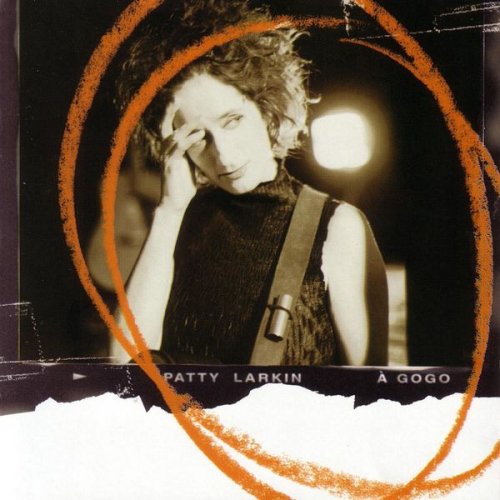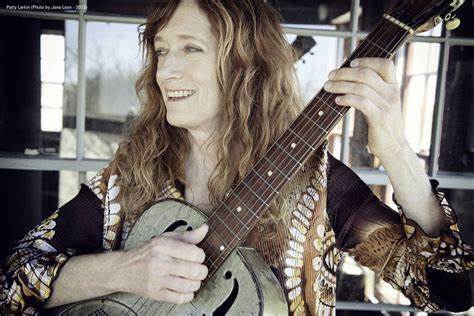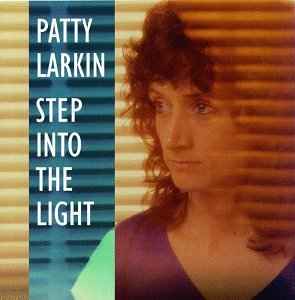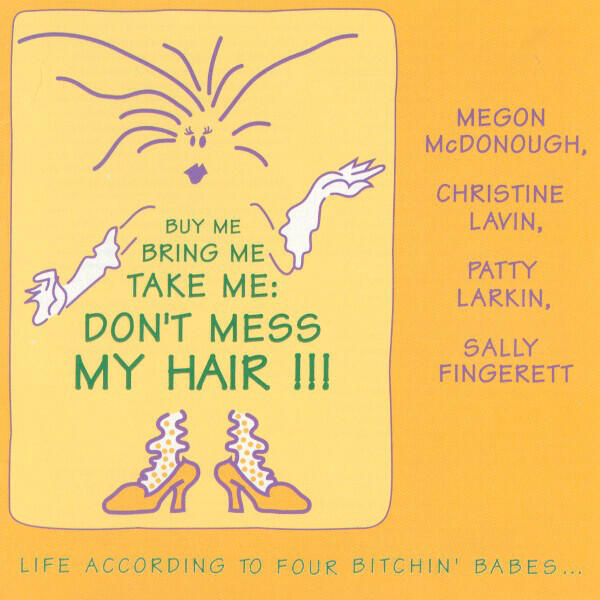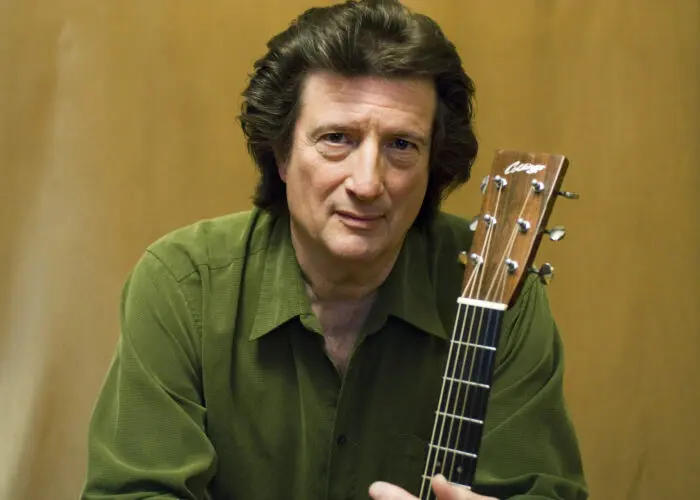Patty Larkin

As anyone with a passing knowledge of folk and rock history knows, Bob Dylan “going electric” at the Newport Folk Festival in 1965 rewrote the rules of both genres and inspired an entire generation of folkies to follow his lead. And as anyone who watched MTV in the 1990s knows, “going acoustic” became the trend du jour after MTV Unplugged debuted in November ’89, with famously electrified axemen like Eric Clapton, Kurt Cobain and Joe Satriani appearing on the show in later years.
But Patty Larkin switched her Strat for a Martin some eight years before MTV Unplugged first aired and not for a night, a brief tour or in an attempt to gain new fans. She made the change as part of a major musical refocus and has walked the softer path full time ever since, using her six-string virtuosity and razor-sharp wit to become one of the most critically acclaimed, commercially successful urban-folk artists of the past four decades.
Overview
Larkin’s talents are a “triple threat,” according to Washington Post music critic Mike Joyce, and distinguish her from the majority of her contemporaries. “She dwarfs most of the folkie competition when it comes to playing acoustic guitar, writes first-rate ballads, broadsides and lampoons, and possesses a voice that can be quietly affecting one moment and hilariously on target the next,” he wrote. Steve Holden of The New York Times said Larkin crafts “self-critical songs that balance passion against bitter observation,” Scott Alarik of The Boston Globe called her lyrics “vivid” and “image-rich” and Grammy-winning singer-songwriter Mary Chapin Capenter has referred to her guitar playing as “badass,” according to Bomb magazine’s Yvonne Conza.
Larkin’s won 11 Boston Music Awards, was named best folk act in a Boston Phoenix–WFNX reader’s poll and has been featured in publications including Guitar Player, Rolling Stone, Acoustic Performer, People and Entertainment Weekly. She’s recorded 14 albums since 1985 (12 studio, two live) and her slide-guitar prowess has been compared to that of Bonnie Raitt and Lucinda Williams.
Musical beginnings
Like Joan Baez, Dar Williams and Cheryl Wheeler, Larkin’s closely associated with New England since she launched her career in the region, but she’s not a native New Englander, having been born some 1,300 miles west of the Atlantic Ocean – in Des Moines, Iowa on June 19, 1951 – and raised in a small town just outside Milwaukee. She grew up in a creative family, her mother being an artist, her father loving all sorts of music and both of her grandmothers being piano teachers; one had played in theatres during the silent-film era and the other was a church organist and choir leader.
Larkin studied classical piano from age seven to around age 11 but lost all interest in the instrument around age 12, after her uncle showed her a few guitar chords. “I was just enthralled by [the guitar],” she told The Minneapolis Star Tribune‘s Liz Kestier. “It was a very personal instrument. I could waddle into my room with it, close my door and be by myself.” By the time she was in high school, she’d started making up new chords and writing her own lyrics since she felt she’d “hit the wall with the number of folk songs I could learn,” she said in a High Street Records biography.
When she graduated from high school in 1969, she’d already been performing solo for a couple years and she continued to do so in coffeehouses and other venues when she was a student at Oregon State University, where she majored in English Literature & Folklore. During her four years there, she played guitar, spoons, harmonica and occasionally fiddle in a jug band in addition to making solo appearances and she’s played accordion in other groups.
Move to Boston, Berklee, Switch to acoustic
In the early summer of 1973, soon after graduating, Larkin visited her sister in Boston and wound up making the area her adoptive home. “My older sister Kathleen’s husband was from the Boston area and was going to Harvard Business School and they were having their first baby,“ she told The Ann Arbor News’ Martin Bandyne in 2013. “I thought that I’d move out there and check out Boston and maybe study some guitar at Berklee College of Music, and I ended up staying.”
She completed a summer program in jazz guitar at Berklee in ’73 but decided to focus on her career instead of continuing her formal studies; in 2002, nearly 20 years after she made that decision, the school recognized her achievements with an honorary doctorate and she’s taught at multiple songwriting seminars there in recent years. While supporting herself with a job at a toy factory, she spent the ‘70s playing electric guitar in various jazz ensembles. In a dramatic shift, however, toward the end of the decade she decided to move away from jazz to concentrate on songwriting. “I realized that if I was really serious about becoming a jazz player, it would take me years to get where I wanted to be on the instrument, and that I’d have to get more contemporary, explore the whole rock thing and get all the pedals,” she told Guitar Player. “That was a little too awesome, so I decided to concentrate on my songwriting instead.”
In 1979/80, Larkin played electric guitar in a rock/R&B band, but she found the genres to be limiting and missed the freedom of solo acoustic gigs. As a result, she decided to switch from electric to acoustic full time in 1981 with the goal of becoming the best singer-songwriter she could possibly be. She spent the early ‘80s busking around local spots like Harvard Square (sometimes with a Celtic group) and as part of a trio with bassist Richard Gates and vocalist Catherine David that opened for a number of well-established folk acts.
Lyrical/on-stage humor, Rounder signing, Albums
By the mid-‘80s, she’d become a popular presence on the New England folk scene and critics noted her extraordinary guitar skills, the brilliant wit within her lyrics and her ability to send audiences into fits of laughter at live shows. In an interview with Seth Rogovoy of The Berkshire Eagle, Larkin said using humor is often the best way to connect with a crowd and that she made her first attempt at doing so at age 16 by playing George and Ira Gershwin’s “I Got Rhythm” out of rhythm. The crowd sat in silent confusion for a few seconds before getting the joke, she said.
Today, Larkin’s notorious for what Joe Brown of The Washington Post calls her “wickedly wry satirical songs” like “Not Bad for a Broad,” “I’m White” and the fan favorite “At the Mall,” in which Larkin impersonates Marlene Dietrich, Carmen Miranda and Ethel Merman. “As a songwriter, one would hope that your most requested song is something moving, and powerful, and almost spiritual,” she once told Kevin Ransom of the Ann Arbor News. “But no. My most requested song is about shopping.”
In 1985, 34-year-old Larkin signed with Rounder Records, which released her debut album, Step Into the Light, on its Philo sublabel that same year to broad critical acclaim. The 12-track outing “introduced us to a fine artist who was musically sophisticated, an astute lyricist, and one who could also show a keen sense of humor from time to time,” wrote George Graham, host of Mixed Bag on NPR affiliate WVIA. In 1987, Philo issued Larkin’s sophomore disc, I’m Fine, which won a Boston Music Award for Outstanding Folk Album.
Self-study hiatus, In the Square, Four Bitchin’ Babes
Despite the unqualified success of I’m Fine, however, Larkin told Guitar Player’s Kevin Ransom that she felt “stuck” artistically, which led to her spending the next three-odd years in intensive self-study trying to further develop her style. Using books and audio material, she focused on incorporating elements of jazz, rock, blues, Celtic and British Isles music into her playing while carefully analyzing the techniques of celebrated acoustic players including Richard Thompson and Bruce Cockburn.
In 1990, Philo issued Larkin’s first live album, In the Square (with her on guitar and bassist Richard Gates) and she contributed to the compilations When October Goes (Autumn Love Songs) and On a Winter’s Night. Also that year, she formed Four Bitchin’ Babes with Christine Lavin, Sally Fingerette and Megon McDonough and the quartet cut the live disc Buy Me, Bring Me, Take Me: Don’t Mess My Hair…: Life According to Four Bitchin’ Babes, issued by Philo.
Hill Street signing, Tango, Other Hill Street albums
In late 1990, Larkin moved from folk-centric Philo to broader-based Windham Hill sublabel Hill Street Records, which critics said was wise given the stylistic transformation she’d recently made. Larkin’s first album for the label, 1991’s Tango, received effusive reviews and critics said it proved that she left Philo at exactly the right time. In a piece for Guitar Player, Ransom noted the dramatic “growth in harmonic complexity” since her Philo years.
Lyrically, the album was more introspective and socially conscious than others – “Metal Drums” is about a toxic-waste disaster in Holbrook, Massachusetts – but it was not without splashes of tongue-in-cheek hilarity, such as the “Dave’s Holiday,” which The New England Folk Almanac referred to as “excruciatingly sarcastic.” Larkin debuted at the Newport Folk Festival in 1992 and recorded three more LPs for Hill Street: Angels Running (1993), Strangers World (1995) and Perishable Fruit (1997).
Vanguard, Signature Sounds, 2000s Albums, Bird in a Cage
After BMG acquired Windham Hill in 1998, Larkin moved to Vanguard Records and recorded her second live album, à gogo, which is a solo performance. She cut three studio LPs for the label, Regrooving The Dream (2000), Red=Luck (2003) and Watch The Sky (2008) – the last of which was a New York Times critic’s choice – and in 2010 she celebrated her 25th year of recording with 25, a collection of 25 love songs sung by 25 different artists and released by Signature Sounds. Guest vocalists include Rosanne Cash, Chris Smither, Suzanne Vega, Dar Williams, Jonatha Brooke, Cheryl Wheeler, Janis Ian and The Nields.
In 2013, Larkin recorded a second album for Signature, Still Green, and in 2020 Signature sublabel Red Narrows issued her latest studio effort, Bird in a Cage. The album reaffirms her penchant for pushing creative limits in that she put 10 poems by 10 different poets to music. Asked why she chose that approach, she said it helped her do what she’s always trying to do: find new ways to express herself. “I had to delve deeper into the poems’ beauty and meaning in order to find the voice to sing them,” she told Bomb magazine’s Conza. “I discovered possibilities for expression available to me by way of a vocal inflection, note choice, variation and tone.”
When Conza asked her what she thought her “impact” has been on the music scene, Larkin was as poetic in her reply as she is in her lyrics. “The music world is a color-full, shiny, screaming, hushed, minutely detailed splash of a jewel that is constantly whirling, spinning into new shapes,” she said. “For me, to be able to say that this is the jewel I have been reaching for all of these years amazes me. That amazement is my impact on the music world.”
(by D.S. Monahan)








